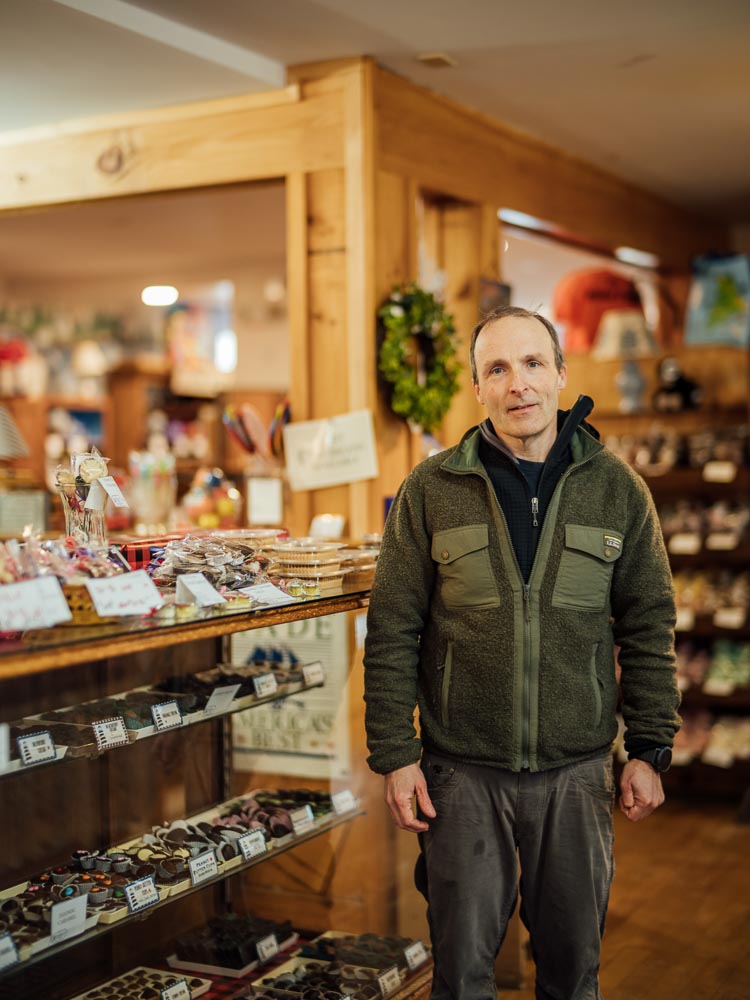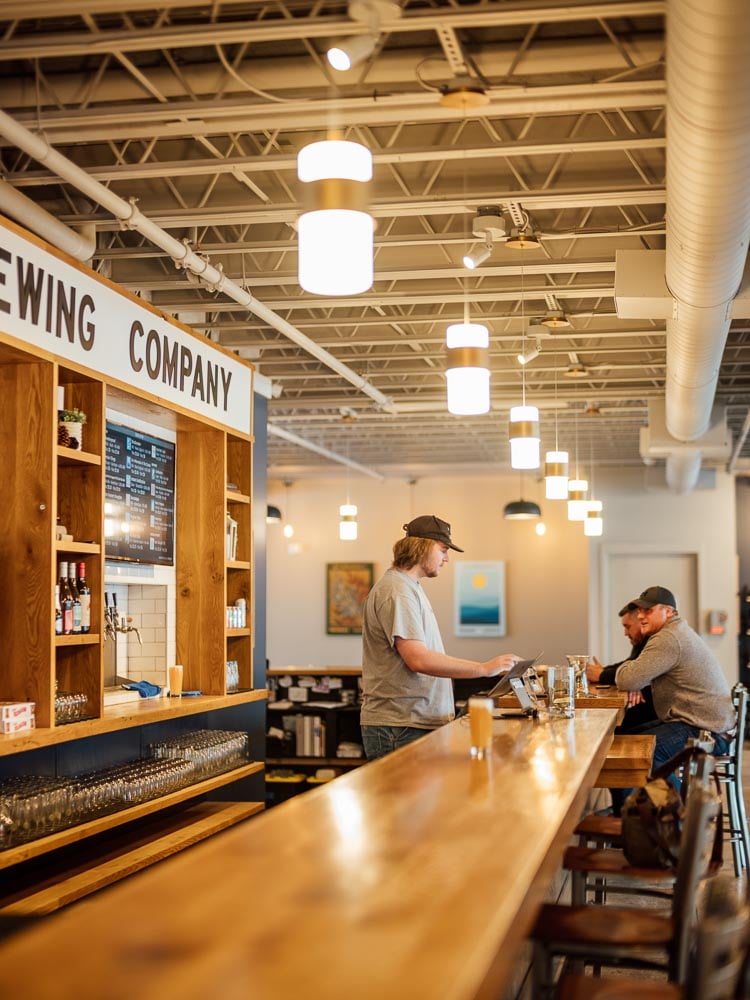By Bridget M. Burns
Photographed by Dave Waddell
From our May 2023 issue
In the 1700s, Freeport was a shipbuilding town. By the mid-1800s, shipbuilding had given way to shoemaking — 30 shoe factories operated in town over the next 100 years, including familiar names like Eastland and, of course, L.L.Bean. In the second half of the 20th century, American manufacturing was in decline, and shoemaking wasn’t immune. Freeport had to pivot again. By the ’80s, it had tapped into the retail boom, with national brands’ outlet stores taking over Main Street storefronts. Eventually, the oldest downtown home became a Starbucks, while Abercrombie & Fitch took over what had been the public library.
Now, Freeport is facing a fresh wave of changes. Brick-and-mortar retail was already struggling, then the pandemic hit. Abercrombie closed, as did a dozen other stores in the past several years, most of them national brands. The downtown vacancy rate cracked 12 percent in 2021, its highest point since the 2008 recession. Some spaces have found new tenants, but many haven’t. The current vacancy rate is around 10 percent. “We recognized the problem on Main Street,” says Tawni Whitney, who was serving on the town council as storefronts were emptying out. “After several years of hoping things would come back around, we were certain, especially with COVID, it wasn’t going to fix itself.”
Now, Whitney is executive director of the Freeport Chamber of Commerce and part of a team that helped develop a revitalization plan — the Downtown Visioning Leadership Team also included the town planner, the town manager, a member of the Freeport Economic Development Corporation, town council members, and others. The group chose to work with a Boston-based urban design and development firm, Principle Group, that has led Main Street renewal projects in the past. Whitney realized the town wasn’t as poorly positioned as she first feared. “Many of the towns the consultant groups are dealing with have lost their one main industry, like when a mill closes down, and they’ve got to start from scratch,” she says. “For us, we have a well-appointed Main Street, we’ve got a great reputation, we have lots of natural resources, and we have a great school system.” Plus, Freeport has the steady presence of L.L.Bean, which opened its flagship store 106 years ago. L.L.Bean is the second-most-popular attraction in the state — behind only Acadia National Park — drawing more than 3 million visitors to Freeport every year.


As Whitney and the rest of the revitalization team drafted plans for the downtown, they looked for community feedback and found that, especially amid the pandemic, residents had the interest and the time to weigh in. “COVID worked to our advantage during that time,” Whitney says. “Everything from town walks to town meetings to surveys, our response rate was very high. We have about 8,500 residents, and we were capturing 40 percent of their voices. We got to hear differences of opinion and where our shared values were.”
The resulting proposal, published last spring, prescribed that “the future of Downtown Freeport should be a welcoming New England Village center and destination for unique local businesses, outdoor recreation, local arts and culture, relaxation, and dining, where people can live, work, and play with walkable and biking connections to South Freeport, the Waterfront, and the region.”
In December, a task force of 40 people, representing 23 local organizations, presented a list of 21 priorities to the town council. Some, like updating zoning rules to align with goals for the future or installing electric-vehicle charging stations on town land, require the direct support of the municipality. Others, such as bolstering arts-and-culture programming, can be led by local nonprofits like Meetinghouse Arts and the Freeport Historical Society. The overall aim of laying out a vision for the downtown is to get the whole community pulling in the same direction.
The key to the whole plan? Bringing housing and locally owned businesses back to Main Street. Andy Wilbur, a Freeport native and the owner of Wilbur’s of Maine Chocolate Confections, a 40-year-old Freeport company, remembers seeing downtown apartments razed over the years. “When I was a kid, some of the shoe factories in Freeport were still operating,” he says. “Those were labor jobs, and in order to afford living on those wages, they had to have reasonable housing. There was a lot of that in Freeport.”
When the outlet stores moved in, parking shortages became an issue. The town council passed an ordinance requiring shops to provide one customer parking space per 150 square feet of retail space and one employee parking space per 1,000 square feet. Private companies built lots and leased spaces to retailers. Some lots went where residential buildings used to be. “It made sense at the time,” says Phil Wagner, owner of Derosier’s, a Main Street pizza and sub shop. “But we kind of went too far in one direction.” Wagner is all for bringing housing back, but he hopes plans will take past problems into account, so the town doesn’t end up on the other side of the equation. “I do have concerns that we go too quickly in the opposite direction,” he says. “I know there’s several big apartment buildings proposed and not near enough parking associated with them.”
The town council has established a housing study group to examine how best to rebuild in-town residential capacity, and Whitney is optimistic a mix that ranges from affordable options for downtown workers to luxury condos geared toward retirees would benefit the whole community. “If you want a vibrant downtown, you have to have downtown living,” Whitney says. “It’s extremely exciting to think about that coming back.” The idea is, essentially, to kick-start a virtuous cycle. “This has been one of the criticisms about Freeport — you can come and shop during the day, but what is there to do at night?” Wilbur says. He, Whitney, and others believe that people moving downtown will attract galleries, bars, restaurants, and entertainment venues, which will in turn attract more people to live downtown, which will attract more small businesses, and so on.
Plans also call for a dedicated team to help identify candidates to fill empty storefronts. To help market Main Street, the Freeport Economic Development Corporation launched choosefreeport.com, providing demographic, consumer-spending, and workforce data, plus commercial real-estate listings and a link to the downtown vision plans. “There needs to be a bigger emphasis on smaller non-chain stores,” Wagner says. “People come to Freeport and they want to go shopping, but they don’t need to see the exact same stores they’re seeing in every mall across America. That makes no sense. If people can shop that anywhere, why come here?”
Wilbur agrees. “We need to figure out a way to make Freeport have niche stores amongst the national chains,” he says. “Some of that’s happening now. I’m hopeful that we’ll have a mixture moving forward to create the kind of individualized culture people like when they visit a town.”
Recent additions to Main Street include Freeport Oyster Bar and Haberdashery Resale Clothing. Vermont Flannel Company has picked Freeport for its first location outside its namesake home state. The Downtown Visioning Leadership Team would also like to see a food-truck park and a brewery join the mix.


While the town has been hashing out its own future, L.L.Bean recently announced a $50 million investment in reimagining its campus that fronts Main Street. “Clearly, there’s a very symbiotic relationship between Freeport and L.L.Bean,” says Greg Elder, the company’s chief retail officer. “To be honest, the downtown vision plan was a pretty instrumental catalyst in getting traction behind this project. Looking at the things the vision plan is oriented on, like a downtown for all that is walkable and bikeable, a small-business ecosystem, and embracing the outdoors, I mean, those are all core tenets of what Bean is as a brand. So the two projects really work hand in hand.”
Plans include expanding Discovery Park, the grassy square that hosts free summer concerts, yoga classes, outdoor movies, and more. “There will be considerably more green space that will be a legitimate community asset,” Elder says. “Think of it as a downtown city park. Success would look like, on any given day, families picnicking and playing games.”
The flagship building will change too. “Back in the day, it was a store and a warehouse and a post office and a variety of things. It’s kind of organically been built up over the years, and it looks as such,” says Elder, who thinks changes at L.L.Bean will complement the town’s plans for Main Street. “By doing this, we believe more retailers, more tenants, more food and beverage operators, more hospitality options, and more artisans will be inclined to invest in bringing their business to Freeport. This should really be an economic boost to the community of Freeport.”
Derosier’s, catercorner from the L.L.Bean flagship, is one of the few other businesses to survive Freeport’s many ups and downs. Phil Wagner’s great-great-grandfather Augustus opened the shop as a grocery in 1904. In the late ’40s and early ’50s, while shoe factories were still the main game in town, grab-and-go food was added for shift workers. “There’d be a line around the corner at lunchtime because everyone piled in to get their ham Italian, with or without onions,” Wagner says. “We would have this giant stack of the sandwiches already made up and someone would be adding salt, pepper, and oil and wrapping them as they went.” Later, as the number of people living downtown declined, demand for groceries waned, and the shop switched fully to operating as a restaurant. “Certainly, more people living in the center of town, near my shop, is good for me,” Wagner says.
Whitney is confident the coming changes in Freeport will be good for everybody. “I know we are going to be better and stronger than we have ever been,” she says. “We’ve been many things over the years. We can do something again in the future.”




